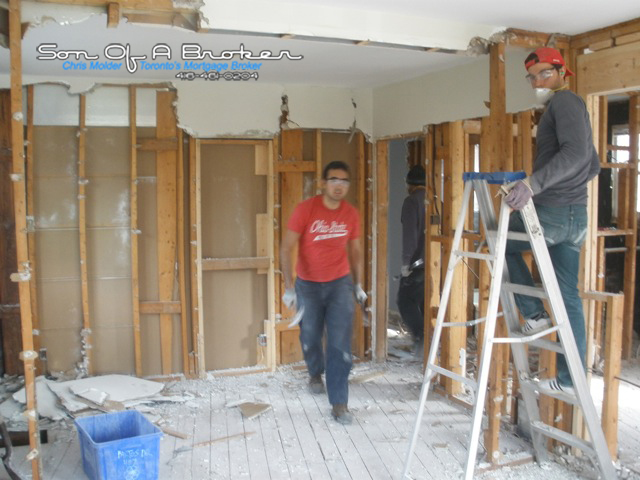Son Of A Broker on the ladder learning to work hard, work dirty, and work for free.
I spent the last 2 weekends out in Oakville learning what it means to work hard, getting dirty and working for free, helping my brother Mark rebuild a 1940s era detached bungalow he bought with his wife.
With stories of multiple offers in the mid teens, I am getting a lot of questions from first-time home buyers thinking of buying an old place and renovating, because frankly, it’s the only affordable option for many in the city. Let me offer you a few insights into the world of purchasing, financing, and renovating.
Buying a home to renovate
Generally speaking, major home renovations are a taboo in the world of mortgages. Let’s step into the mind of the lender for a second. Think of a lender as the ultimate pessimist, always concerned with the worst possible scenario. A finished home (no matter how dated the kitchen looks) is the lender’s security should you default on your mortgage. If you undertake a major home renovation, ripping out the walls, bathrooms, and kitchen, then suddenly find yourself unable to pay the mortgage. Without money to finish your little renovation project, the lender would end up with an unfinished unmarketable home. Lenders are not in the home renovation and flipping business, and are very adverse to lending on unfinished homes or the proverbial “handy man’s” dream home.
Although, one could argue that the lender’s position is being improved by the home improvements because value is being created in the property. With the exception of specialized private construction financing ($$$$$$) and “Purchase Plus Improvement” Programs offered through some lenders (which are restrictive and in many cases difficult and impractical to execute), home buyers who wish to purchase and renovate are really left to their own devices.
Here are a few tips if you’d like to get you hands dirty:
Things to keep in mind
1- The lender will ask for a copy of the MLS listing and even an appraisal in some cases. If the home is marketed as a fixer upper and really inhabitable by only the racoons in the attic, chances are you may have a hard time with the funding.
2- If you have 20% available for the down payment and you’re thinking of putting the money down then turning around a getting a line of credit or HELOC, keep in mind that they can only be arranged up to 80% of the appraised value of your home.
3- Lenders are only lending based on the current market value of the home as is. They aren’t interested in what the future value will be after the installation of the imported Italian cabinets and fair trade bamboo floors.
4- Your best chance of successfully proceeding with a project like this is to purchase with the minimum 5% down and keep all the money you would have used available as cash to undertake the project.
5- While I shouldn’t discredit the worth and value of paying a contractor, if you are a first-time homebuyer with limited resources, unless you are going to do it yourself then the costs of hiring someone may be too high.
6- If you do proceed, I would recommend either a variable rate mortgage or fixed mortgage with a shorter term (2 or 3 years). This way, the penalties are at a minimum or avoided if and when you do refinance.
If you need to discuss your mortgage, contact me here or schedule a call directly into my calendar below.
